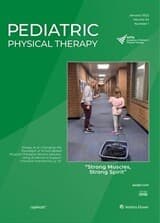Science
Interviews in this edition: 1. Amy F Bailes, PT PhD, Physical Therapist, Division of Occupational Therapy & Physical Therapy, Cincinnati Children's Hospital Medical Center, Cincinnati, OH, USA. “Describing the Delivery of Evidence-based Physical Therapy Intervention to Individuals with Cerebral Palsy”. Analysis of a large dataset of real-world experience from physical therapy sessions among children with cerebral palsy to examine variation by age, Gross Motor Function Classification System, race, and insurance type. Most frequently delivered were: Caregiver education, motor control, functional strengthening, ankle-foot orthoses, treadmill training, and fit of adaptive equipment. 2. Julia Looper PT PHD, School of Physical Therapy, University of Puget Sound, Tacoma, Washington, USA “Current Trends in Pediatric Physical Therapy Practice for Children with Down Syndrome” A survey from 1,000 American pediatric physical therapists examined the breadth of physical therapy practice for children with Down syndrome, concluding that clinicians managed these children for a wide variety of needs with a range of interventions. 3. Rebekah L. Johnson, PT DPT, Pediatric Physical Therapist, Mealtime Connections, Tucson, AZ, USA Current Trends in Pediatric Physical Therapy Practice for Children with Down Syndrome This survey examines the breadth of physical therapy practice for children with Down syndrome. Rebekah Johnson, first author, agreed that the diversity of practice among American physical therapists who managed children with Down Syndrome had been a key finding and that clinicians reading the report could learn from their findings. But there had been an ongoing need to match the evidence-base to current practice. 4. Marybeth Barkocy PT, DPT, PCS, Physical Therapy Division, Associate Professor, University of New Mexico School of Medicine, Albuquerque, NM, USA. The Effectiveness of Serial Casting and Ankle Foot Orthoses in Treating Toe Walking in Children with Autism Spectrum Disorder “This proof-of-concept study examined the effectiveness of serial casting and ankle foot orthoses in children with Autism Spectrum Disorder who toe walk.” 5. Cheryl I. Kerfeld PT, MS, PhD, Special Education Department, Seattle Public Schools, Seattle, Washington, USA Physical Activity Measurement in Children Who Use Mobility Assistive Devices: Accelerometry and Global Positioning System A study of the usefulness of combining accelerometry, global positioning system, and geographic information systems, to describe the time spent in different locations and physical activity duration and level by location for four children with cerebral palsy who use assistive devices. 6. Caroline Martinsson MSc, Habilitation & Health, Children and youth habilitation Borås, Region Västra Götaland, Sweden Abducted Standing in Children With Cerebral Palsy: Effects on Hip Development After 7 Years This study looked at the effects of abducted standing on hip migration. Both the percentage and range of hip and knee motion in children with cerebral palsy were studied for more than seven years in two case-control groups. 7. Laura Graber PT DPT, College of Public Health and Health Professions, Gainesville, Florida, USA Upper Extremity Strengthening for an Individual with Dyskinetic Cerebral Palsy: A Case Report “The purpose of this case is to describe an exercise program designed for an individual with athetoid cerebral palsy who had difficulties with fine motor control and shoulder girdle stability.” “A progressive exercise program aimed at improving proximal stability and fine motor function might be an appropriate intervention for persons with athetoid cerebral palsy”

